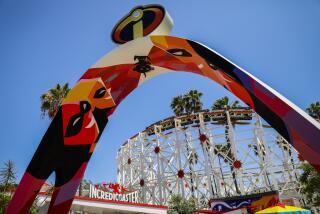Medics, ER Wouldn’t Give Up on Boy at Death’s Door
- Share via
Nurse Sherlene Stepp doesn’t know Brandon Zucker. Neither does Dr. Marianne Cinat nor emergency medical technicians Gabriel Gomez and Brian Cole. They’ve never heard his voice. They’ve never seen him smile.
But the 4-year-old boy’s life was in their hands. In a scene they describe as “organized chaos,” each worked desperately to save him after he was trapped several minutes beneath a vehicle in the Roger Rabbit’s Car Toon Spin attraction at Disneyland a week ago.
His parents, David and Victoria Zucker of Canyon Country in northern Los Angeles County, and close family friends have been keeping a round-the-clock vigil in his room in the pediatrics intensive care ward. Brandon remained in extremely critical but stable condition late Friday.
Doctors don’t know yet whether he will live, but as he rested in a drug-induced coma, hooked to intravenous lines and a ventilator to help him breathe, they said they aren’t giving up.
“We have the same goals,” said Stepp, an emergency room nurse at UCI Medical Center in Orange. “We want Brandon to walk out of here.”
For emergency and medical workers, it started with a 911 call from a Disneyland employee at 10:19 p.m. Sept. 22.
“We need paramedics to come to Gate D-7. . . . We have a child [pause] stuck underneath one of the cars in the Roger Rabbit. [pause] I don’t have an age, I’m trying to find out if he’s breathing. [garbled] [pause] Start rolling and we’ll get you the info if we can.”
The scene was frenzied and horrific, witnesses said. People screamed. David Zucker shouted to stop the ride. Some guests fled while others pushed past park attendants to help with the rescue.
By the time the ride stopped, Brandon was lodged under a heavy “taxicab.” His lifeless 45-pound body was sandwiched head to knees in a narrow space--about six inches--between the ground and the ride, witnesses said. The pressure fractured his pelvis, collapsed a lung, and tore his liver, spleen and diaphragm.
CARE Ambulance emergency medical technicians Gabriel Gomez and Brian Cole were nearby. Lights flashing and sirens blaring, they raced to Disneyland Code 3, the highest level of emergency response down rain-slicked streets.
The details had been sketchy, but they prepared for the worst: a heavy rescue, Disneyland, a child.
Don’t think about it, they said. Just do your job.
At 10:23 p.m., four minutes after the call came in, Gomez and Cole arrived at the Anaheim amusement park. They rushed past Brandon’s frantic father and crying mother, focusing only on the boy, who had been freed from beneath the car.
He lay flat on the ground. Anaheim Fire Department paramedics had cut the clothing off his battered body. Gomez and Cole saw that his color was ashen, turning to bluish purple from lack of oxygen.
Paramedics hovered over him, working, pumping air into his little body. Park firefighters and nurses were on scene as were Anaheim police officers and a crew of nine from the city’s Fire Department.
“You’re doing good, Brandon,” paramedics said over and over, as if willing him to breathe because, as Cole said, they believe patients can hear the encouraging words.
Gomez grabbed a backboard. Cole found a child-sized cervical collar. They lifted Brandon quickly but gently into Anaheim Ambulance One. The unconscious boy had a pulse, but it was weak. He could not breathe on his own.
Everyone Races to Emergency Room
At 10:39 p.m., the radio room in the trauma unit of UCI Medical Center got its first call for a “pediatric full arrest”--a child with no heartbeat, no breathing.
The emergency staff was alerted via the “red phone,” and nearly a dozen people were paged.
Within minutes, an attending doctor, chief resident, two junior residents, an emergency medical technician, a respiratory therapist, two nurses, an X-ray technician and an emergency physician converged in the ER.
Trauma surgeon Cinat had just gone home, and was about to take her first bite of dinner. She got the page and jumped.
“You drop everything and get there,” she said.
Paramedics aboard the speeding ambulance didn’t let up. Gomez tried to measure Brandon’s blood pressure, which was so low he couldn’t take a reading. A paramedic sat on the edge of the gurney. He stuck a needle in Brandon’s foot and attached an IV. Another medic kept in radio contact with the hospital.
They kept repeating: “Good job, Brandon! You’re doing good!”
In the front seat, Cole’s eyes were on the road. Beside him sat Brandon’s frantic mother, Victoria Zucker. She was singing one of Brandon’s favorite songs, encouraging him through her tears. “Don’t worry, Brandon. You’re OK. Hang in there,” she said.
As paramedics focused on Brandon, they closed a dividing door between themselves and the mother, who was conveying emotions they couldn’t afford to consider.
“Brandon’s a strong kid,” she told Cole. “He’s strong. He’ll pull through.” But she was scared too. “Is he going to die?” she asked the driver.
“I was telling her that these are the best paramedics in the country and he’s going to the best hospital in Southern California,” Cole said. That there was “nothing better we can give him.”
At 10:50 p.m., the ambulance and Cinat arrived at hospital at the same time. Nearly a dozen hospital staff surrounded Brandon. Each had a role.
They opened his airway, hooked him to monitors measuring his heartbeat, blood pressure, even the oxygen in his blood. His color had worsened. They knew it was bad, but they pushed those thoughts aside.
“You always assume you can save that person’s life,” Cinat said.
They wheeled him in for a brain scan and whisked him into surgery.
Then they stopped for a deep breath and thought, this isn’t fair.
“I think the day you don’t cry with a parent is the day you need to quit,” Stepp said.
It’s been a week, but Stepp still visits Brandon. The paramedics keep tabs on his condition too. Cinat remains his doctor.
“I want to have good news,” said Cinat, drained from a week of waiting. “Really, it’s moment to moment. This is very hard for everyone.”
Donations to Brandon Zucker’s medical fund can be made at any Washington Mutual branch or via check, payable to “The Family of Brandon Zucker,” 910 S. Brookhurst St., Anaheim, CA 92804.
*
Times staff writer Jessica Garrison contributed to this report.
More to Read
Sign up for Essential California
The most important California stories and recommendations in your inbox every morning.
You may occasionally receive promotional content from the Los Angeles Times.














